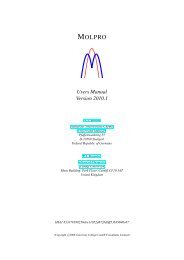CHAPTER III. ELECTROGRAVIMETRY AND COULOMETRY I ...
CHAPTER III. ELECTROGRAVIMETRY AND COULOMETRY I ...
CHAPTER III. ELECTROGRAVIMETRY AND COULOMETRY I ...
You also want an ePaper? Increase the reach of your titles
YUMPU automatically turns print PDFs into web optimized ePapers that Google loves.
Reference electrode - maintain a constant potential irrespective of changes in<br />
current.<br />
Counter (auxiliary) electrode - to complete the electrochemical cell but its potential<br />
is rarely of interest.<br />
ii/. Amperostatic Coulometry (Controlled-Current Coulometry)<br />
FIGURE 3-7. “Bard” Fig. 10.4.1 (p. 385).<br />
When applied current < limiting current, current efficiency = 100%<br />
When applied current > limiting current, current efficiency < 100%<br />
The selectivity is poorer than the controlled potential method.<br />
iii/. Coulometric Titrations<br />
Employs a titrant that is electrolytically generated by a constant current, i.e.,<br />
unstable reagents such as Ag 2+ , Cu + , Mn 3+ , and Ti 3+ can be generated and used in a<br />
single vessel.<br />
FIGURE 3-8. “Harris” Fig. 17-9 (p. 382).<br />
Some external means must be used to determine the end-point of the reaction, e.g.,<br />
visual indicators, potentiometry, amperometry, and photometry.<br />
e.g., 2Br − → Br 2 + 2e<br />
H 2 C=CH 2 + Br 2 → H 2 BrCCBrH 2<br />
iv/. Applications<br />
a) Neutralization, Precipitation, and Complex-Formation Titrations<br />
TABLE 3-9. “Skoog” Table 21-1 (p. 529).<br />
b) Oxidation/Reduction Titrations<br />
TABLE 3-10. “Skoog” Table 21-2 (p. 530).<br />
v/. Comparison of Coulometric and Volumetric Titrations<br />
Advantages:<br />
a) Absolute technique needing no standard solution - minimizes errors in<br />
3











![Hetero [6+3] Cycloaddition of Fulvenes with N-Alkylidene Glycine ...](https://img.yumpu.com/35423358/1/190x245/hetero-6-3-cycloaddition-of-fulvenes-with-n-alkylidene-glycine-.jpg?quality=85)




